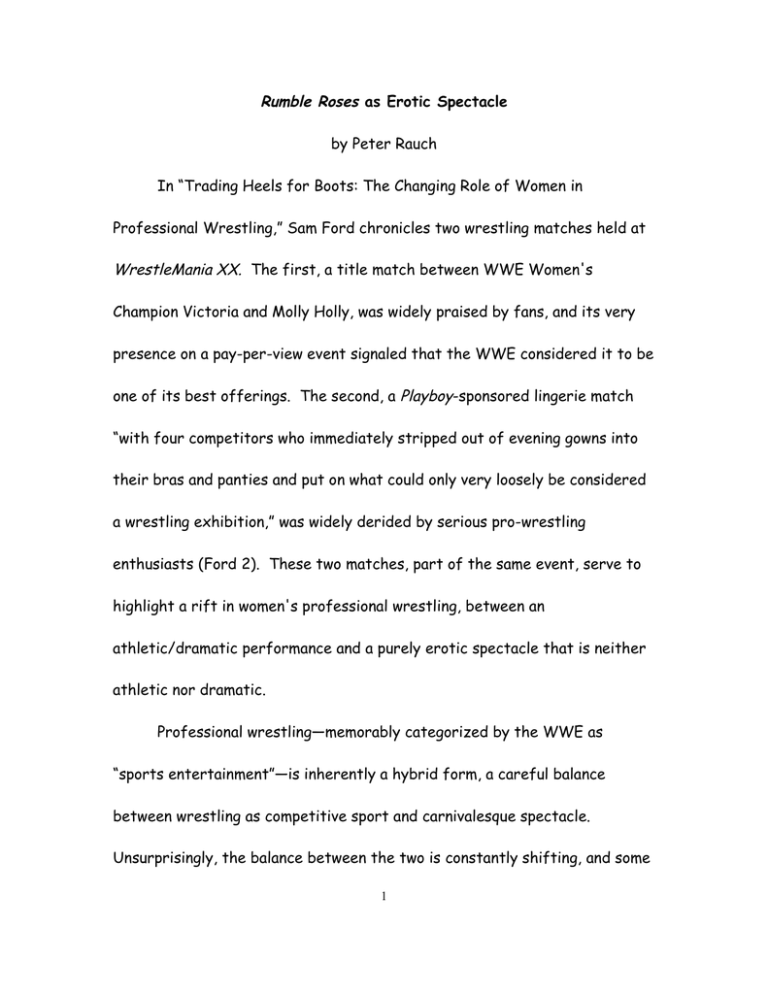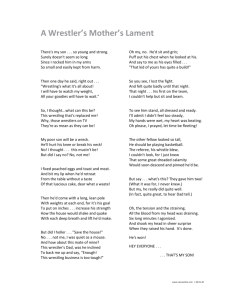Rumble Roses as Erotic Spectacle by Peter Rauch
advertisement

Rumble Roses as Erotic Spectacle by Peter Rauch In “Trading Heels for Boots: The Changing Role of Women in Professional Wrestling,” Sam Ford chronicles two wrestling matches held at WrestleMania XX. The first, a title match between WWE Women's Champion Victoria and Molly Holly, was widely praised by fans, and its very presence on a pay-per-view event signaled that the WWE considered it to be one of its best offerings. The second, a Playboy-sponsored lingerie match “with four competitors who immediately stripped out of evening gowns into their bras and panties and put on what could only very loosely be considered a wrestling exhibition,” was widely derided by serious pro-wrestling enthusiasts (Ford 2). These two matches, part of the same event, serve to highlight a rift in women's professional wrestling, between an athletic/dramatic performance and a purely erotic spectacle that is neither athletic nor dramatic. Professional wrestling—memorably categorized by the WWE as “sports entertainment”—is inherently a hybrid form, a careful balance between wrestling as competitive sport and carnivalesque spectacle. Unsurprisingly, the balance between the two is constantly shifting, and some 1 matches will prioritize one over the other. Women's wrestling offers a complicating factor: in a sport/spectacle that is usually (and incorrectly) assumed to have a near-exclusively male, heterosexual audience, the prospect of women in violent embrace adds unavoidable sexual overtones to an already complex symbolic exercise. Though its history is long and complex, women's pro wrestling of the modern, WWE-dominated era has been criticized for having moved away from dramatized athleticism in favor of an overtly sexual spectacle. I will argue that the videogame Rumble Roses exploits the unique features of the videogame medium to expand on the experience offered by this particular form of women's pro wrestling, offering a disembodied experience that magnifies and exaggerates the homoeroticism, voyeurism and sadomasochism inherent in pro wrestling. To that end, I will examine symbolic understandings of professional wrestling in general, comparing and contrasting it with a symbolic understanding of the videogame medium. I will then explore the genre history that precedes Rumble Roses, and the history of female characters in competitive fighting games. Finally, I will look at the text itself from the perspectives of the designers, critics, fans, and myself as a player. In “The World of Wrestling,” Roland Barthes eschews the idea of 2 wrestling as sport and defines it instead as spectacle, a ritual for the enactment of suffering. “Each sign in wrestling is [...] endowed with an absolute clarity, since one must always understand everything on the spot. As soon as the adversaries are in the ring, the public is overwhelmed with the obviousness of the roles” (Barthes 24). The performers do not act out roles; rather, the signs which constitute the roles are embodied by the performers. The religious significance of this embodiment—word made flesh—is not lost on Barthes: “In the ring, and even in the depths of their voluntary ignominy, wrestlers remain gods because they are, for a few moments, the key which opens Nature, the pure gesture which separates Good from Evil, and unveils the form of a Justice which is at last intellegible” (Barthes 32). Popular culture is, at this cultural moment, not suffering for want of these moments of unveiled intelligibility, as every entertainment medium has its tales of seemingly timeless signs embodied in larger-than-life combatants. What makes the ritual enacted in the wrestling ring qualitatively different than that enacted by, for example, a comic book superhero facing off against a supervillain, is the primacy of the body, a body that is bound in space and time, fixed to a single perceptible reality with largely predictable physics: the “real” world. 3 Wrestler's bodies, existing in the real world, are more limited than the bodies imagined in the fictional worlds of film or literature. No injury is sufficient to take down the Supermans and Batmans of the world. Pages can be redrawn, injuries can be represented with special effects, and even fatalities can be reversed. Fictional characters routinely walk away from the kinds of falls that killed Owen Hart. Ultimately, it is literally impossible to bring death to an entity that exists at the whim of an author. Real human bodies are not so invulnerable. Yet, in the WWE era, wrestlers appear to perform tasks that are clearly delineated as superhuman, and to survive brutal assaults that the audience knows, rationally, would cripple kill a mere human being. Through careful stagecraft, wrestling transcends the limitations of liveness, making its performers simultaneously embodied (real) and superhuman (fake). No non-live (dead?) medium has been able to replicate this semiotic feat. Videogames, an inherently syncretic medium, offer a new perspective: simulation. Videogame theorist Gonzalo Frasca defines simulation as the act of modeling “a (source) system through a different system which maintains (for somebody) some of the behaviors of the original system” (223). Making a distinction between simulation and representation, Frasca writes: 4 Traditional media are representational, not simulational. They excel at producing both descriptions of traits and sequences of events (narrative). A photograph of a plane will tell us information about its shape and color, but it will not fly or crash when manipulated. A flight simulator or a simple toy plane are not only signs, but machines that generate signs according to rules that model some of the behaviors of a real plane. (223 224) Despite the irreducible difference of liveness, wrestling shares its representational mode with Frasca's “traditional media.” Wrestling makes of the human body a representational medium in a very explicit way. Videogames, in their capacity for simulation, offer an alternative that is ironically more akin to wrestling than any non-live representative form: the simulation of bodies. The bodies in this case are fictional, of course, but nonetheless they operate according to set physical rules that need not be manipulated by visual trickery. Once created, they do not need constant human intervention to continue existing, as would be the case in comic superheroes. The bodies simulated are not bodies as they actually exist, but bodies as wrestlers and fans pretend they are. In this sense, videogames approach the superhuman not by representation or simulation, but by simulation of representation. Since simulated bodies do not adhere to the limitations of live ones, 5 simulations of representations of the superhuman need not restrict themselves to the comparative safety of the wrestling ring. Tournament fighting games, in which characters attempt to beat each other into unconsciousness or death with very few explicit rules, constitute a spectacle closely akin to professional wrestling. On a symbolic level, these games are closer to professional wrestling than games based on professional wrestling, since the latter are using rules and moral structures that make sense for a live, viewed event, but not for an interactive, simulated event. Rumble Roses is a videogame developed by Yuke's and released in 2004.1 Based on a simplified version of an engine previously designed by Yuke's for use in the WWE-licensed SmackDown series of games, Rumble Roses features an original all-female cast. This, in and of itself, is unusual in the context of videogames, since the reasons that might make intergender competition problematic in “real-life” athletic events do not exist in videogames, as the abilities of videogame characters are fundamentally unrelated to the size or composition of their virtual bodies. Since Rumble Roses uses original (i.e. not real) characters in a fantastic (i.e. not realistic) storyline, the absence of male characters is particularly noticeable. 1 A sequel, Rumble Roses XX, was released in 2006, but I am here concerning myself only with the first game, unless otherwise noted. 6 Professional wrestling, like videogames, has traditionally been understood as an explicitly masculine space, and not entirely without reason. Sharon Mazer suggests that the presence of women in the ring, regardless of their functional similarity to male wrestlers, changes the nature of the spectacle: By definition, the spectacle of women wrestling violates a conventional sense of what is feminine and, thus, flirts with conventional sexual boundaries. In contrast to the generally masked undercurrent of male homoeroticism which remains largely obscured by assumptions of heterosexuality, the sexual aspect becomes a highly visible component of a women's event. But the sexuality in this case also bypasses the women in the audience. A match between women is explicitly heterosexual, a direct invitation to male fantasies and sexual aggression rather than an expression of subjective female desire. (Mazer 118). That Rumble Roses is neither based on real people nor operating within a realistic universe eliminates the traditional reasons for isolating women from men. In fact, men seem to be altogether absent from the proceedings: there are no supporting characters, male or otherwise. The only characters appearing in any detail in the game are the wrestlers themselves, not one of which would be considered unattractive by modern standards, and all of which are dressed in such a way as to make this fact as easy as possible for a presumed male, heterosexual audience to discern. The 7 only males in evidence are in the audience, presented in low graphic detail and receiving little attention from the in-game “camera.”2 Well-publicized concerns about sexism aside, it's rare to find videogames without at least some female characters. The problem has traditionally been the question of what constitutes a realistic, welldeveloped, or progressive female character, in a medium that often privileges fan narratives over authorial narratives. In addition, videogame designers and cultural critics have historically operated under the same assumptions as wrestling promoters and critics, specifically that the audience consists entirely of heterosexual males. One-on-one fighting games, in particular, have had prominent female characters since Capcom's 1989 release of Street Fighter II. Street Fighter II is a tournament fighting game with eight playable characters, two of which are clearly delineated, in terms of both narrative and gameplay, as hero protagonists.3 The remaining six playable characters are less effective fighters, many of whom are based on characters and 2 The audience is uniformly male for most of the matches; the only exceptions are mud wrestling matches, which take place at a beach. For these matches, roughly half of the audience is female, this fact made rather explicit by the fact that all female audience members are dressed, like the wrestlers themselves, in bikinis. 3 While it is more common, in terms of stories, to have a single hero protagonist, the exigencies of the genre, which emphasizes two-player simultaneous play, necessitated two. They are functionally identical. Later developments in the genre eliminated the distinction between main characters and side characters. 8 archetypes from popular films. These side characters act as a sideshow of sorts, in that their primary contribution is variety. Among those featured is one female character named Chun Li, clearly inspired by the character Su Lin from Enter the Dragon. Chun Li quickly became a fan favorite, and female characters became a staple of the genre. As graphic technology improved and videogames increasingly evolved into transmedia properties, female characters were increasingly sexualized. This trend reached an apex of sorts with the 1996 release of Tecmo's Dead or Alive, a tournament fighting game featuring three playable, highly sexualized female characters and a simple grappling system reminiscent of wrestling games.4 Ironically, in 1996, Dead or Alive—with its fantastic storyline, rivalries between characters, and pre-match trash-talking—more closely resembled modern pro wrestling than did the games licensed by the WWF itself, which tended to present themselves more like sports games. While it did offer legitimately new gameplay concepts, Dead or Alive was better known for its female characters' pendulous, bouncing breasts. The developer capitalized on this notoriety with the release of Dead or Alive: Xtreme Beach Volleyball, which jettisoned both all the male cast members and the idea of hand-to-hand 4 Although many tournament fighting games have featured pro wrestlers as playable characters, Dead or Alive was the first to put a woman, Tina Armstrong, in that role. 9 combat in general. Street Fighter II and Dead or Alive are as much in Rumble Roses' lineage as wrestling itself, and the perception of female characters in fighting games, from Chun Li to the female combatants of Dead or Alive, follows a pattern not unlike that of women in “real” professional wrestling: beginning as a sideshow of sorts, gaining popularity and legitimacy, and eventually becoming something else altogether. Dead or Alive never did manage to be taken seriously as by critics or fans of the genre. The very presence of such overtly sexualized female bodies—over-the-top even by videogame standards—seemed to be a barrier to the public's ability to take the games seriously. Though attempts were made to make sequels appear more “serious,” most notably by toning down the breast bouncing, the series would eventually embrace its Maximesque reputation in the Xtreme spinoff series. Dead or Alive can thus be seen as a series in which the sexualization of its female characters, only incrementally more advanced than that of previous games with intergender casts, came to overwhelm the public's perception of the game and eventually necessitated an entire change of genre. The cast of Rumble Roses is understandably larger than the female 10 portions of most intergender fighting or wrestling games. However, it is clear that the designers had very specific goals in mind when creating these characters. Writes critic Alex Navarro: Each of the game's lovely ladies is based on one tired stereotype or another: there's the Ryu [white-hat protagonist from Street Fighter II]-like Reiko, determined and focused solely on her wrestling; the Texas-born cowgirl Dixie Clemets; and the dark and mysterious female ninja, Bloody Shadow. However, many of the other characters transcend mere stereotypes, and they actually seem to more closely represent a number of seedy fetishes. There's the disciplinarian schoolteacher; the naughty, pigtailed school girl; the deviant nurse (complete with plenty of medical-based puns); and the latex-sporting S&M slave. Rivalries between these characters have, true to form, been written into the game, though storylines are not consistent across game modes. In an interview with Kikizo Games, Rumble Roses creator Akari Uchida acknowledges that game's inspiration came not from wrestling but from women's bodies: The first idea that we had a long time ago was that we wanted to see how good a female character model we could create. My team and I were presenting numerous concept documents to upper management, but most of them were rejected! But since wrestling games like SmackDown! are very popular, and games like Tekken are also very common, we came up with using the female character models with fighting action, so that you can see the girls slowly, but exciting at the same time! 11 Just as the designers' conceived of the game as being about women's bodies first and the activity of wrestling second, Uchida makes it clear that he expects players to react to the title the same way: We assume that almost all users will buy the game because they view it as an erotic title or something, just for fun. But even these users will end up appreciating that the game has great balance between the gameplay system and the erotic expression, so it's not just an erotic game. But you can play for fun as well. That the actual wrestling content is considered secondary—added value on top of the game's primary function as erotic spectacle—is precisely the complaint most often leveled against some of the WWE's recent women's matches. It is fitting, then, that Rumble Roses runs on an engine designed for a WWE-licensed title with primarily male characters, made less complex for application to women's wrestling. Uchida's assumptions about the game's appeal seem to be proven largely correct by critical and fan response. For a poorly reviewed game of modest commercial success, Rumble Roses nonetheless has a small but enthusiastic fan community.5 The two major fansites I managed to locate, Roses Tenkoku Tenshi and rumble 5 My ability to research the fan community might be somewhat limited by my frustrating inability to read Japanese. It's possible that there exists a more vibrant fan community outside the English-speaking portion of the internet. 12 roses.net, focus heavily on pictures (both captured from the game and rendered by fans) and movies of the wrestlers. Most of the image galleries and movies focus not on action scenes, solo pictures of the characters in provocative poses. In “'Ladies Love Wrestling, Too': Female Wrestling Fans Online,” Catherine Salmon and Sue Clerc note that on fansites devoted to “real” wrestling, this treatment is common, but only for female wrestlers and male audiences: The absence of ass and crotch shots in galleries built by female fans is a marked contrast to pictures of female performers at male fan sites. When “Nitro” Girl Chae's top slipped during a dance routine and accidentally revealed a breast, it became the nipple seen round the world, thanks to male fans with frame grabbers and websites. Frequently, pictures of the women are relegated to a special section of a site devoid of wrestling content. [...] Male fans are aided by the industry's pandering— the WCW and WWF have published videos and photo spreads, as it were, of their female performers. (174) In Rumble Roses, the “video and photo spreads” are obviated by the content of the game itself, which functions very similarly. Elsewhere, message boards offer a varied portrait of fan response, with many posts devoted to unlocking of content and many devoted to aesthetic discussions of the women in question. Less common are posts relating to strategy, character balance and the competitive aspect of the game. In addition, fan 13 fiction exists, though in smaller numbers than more successful games. Character rivalries and WWE crossovers seem to be the most common themes. Taken as a whole, the message boards suggest a game appreciated primarily as spectacle, and not as a “sport.” This seems entirely consistent with wrestling fan culture in general. Just as wrestling seems to take a backseat to spectacle, so does active gameplay. One thing that stands out, upon spending any length of time playing Rumble Roses, is exactly how little time one spends in active gameplay. Cut-scenes abound in Rumble Roses, from the music video that accompanies the game's introduction to the elaborate entrance videos for each wrestler to the conversations between matches in story mode. Even during the matches, most holds subjugate play to viewing, stopping the active gameplay for several seconds while the camera lingers on the two combatants grappling in sexually suggestive poses. The homoerotic elements of wrestling are largely self-evident, and little more need be said about them. Working from Mazer's assertion that the presence of women in the ring changes the nature of the activity of wrestling, it seems that women's wrestling only makes more apparent (to some) an aspect of the spectacle that has always been there. It would be 14 difficult to deny an explicitly and intentionally homoerotic aspect of Rumble Roses, a game in which the central activity depicted is that of attractive, half-naked women pulling and squeezing each others' bodies in view of a camera that unerringly centers its shots on the wrestler's breasts, buttocks and groins. This spectacle is clearly framed as being sexual for the audience (both the in-game audience and the players), but the perspectives of the performers themselves is more difficult to discern. Put more succinctly, it is not obvious whether or not the game characters consider their profession of choice to be an inherently sexual one. A subtext is certainly there to be found—the subjective camera-work in cut-scenes suggests that the wrestlers look upon each others' bodies in a way that is traditionally coded as sexual, and there are a few double entendres to be found in the dialogue —but the mainstream videogame industry remains fairly restrictive when it comes to representations of homosexual desire. At risk of making a common critical mistake, it is important to note that female homoeroticism, marketing trends to the contrary, is not solely the domain of heterosexual male audiences, and it's possible that Rumble Roses lends itself to a number of queer readings. My sense, based on the words of the designers and the interpretations of critics, is that any latent homoerotic elements, already 15 present in pro wrestling, are intended to underscore the game's function as erotic spectacle. The emphasis on viewing, rather than participating, places the player in an unusual position, further complicated by the dual nature of the avatar. In videogames, the avatar—roughly defined as the person or thing controlled by the player—functions simultaneously as a projection of the player into the gameworld and a fictional character who is not the player, generally the protagonist. Different games balance these two roles differently. Some present the protagonist as a tabula rasa, creating a space in which the player may project their own characteristics onto the avatar, while others have detailed scripts for the protagonist, making the role of the player closer to that of an actor in a scripted drama than a free entity in a world. The difference does not concern the events depicted in gameplay so much as the meaning of these events, in whether the protagonist's reasons for performing certain actions are so explicit as to trump the reasons the player may impose. In games that prioritize the identity of the protagonist over that of the player, the play experience approaches that of a film, and the player becomes an audience member. What direct interaction with the character remains serves to magnify the sense of passivity, of being more 16 audience member than player. While the most passive player experience remains more active than an audience experience, the passivity is more apparent from the perspective of a player. Consequently, the experience of Rumble Roses is in many ways more voyeuristic than it would have been had it been a film instead of a videogame. The emphasis on the visual spectacle of the wrestlers' bodies (with carefully scripted movements), frequent cutscenes, and the “gallery” mode (explained below), ensures that playing Rumble Roses feels less like embodying a protagonist than controlling an entity that already exists, arranging them in such a way as to produce a more effective spectacle. The player's role is perhaps closer to that of a booker than that of a wrestler. Gameplay itself is divided into two modes: story and exhibition. There are ten characters to start with, each designated as a face or heel, though these labels are applied inconsistently both within and between the two modes. In story mode, players select a wrestler and play through a series of matches, interspersed with cut-scene conversations, culminating in a battle with the villainous Lady X. “Story mode” is the term commonly used for the single-player mode in genres not known for deep or interesting stories. The story of Rumble Roses, beyond the league or division for which the game is 17 named, has to do with a wrestler named Anesthesia (the aforementioned nurse) who has built a cyborg using genetic material from a legendary female wrestler named Kamikaze Rose. Anesthesia hopes to improve on the design by stealing genetic material from the current Rumble Roses competitors, which may or may not entail killing them. It never makes a whole lot of sense, which is (again) an impressive feat, given how low the standards are in videogames. At best, story mode establishes some scripted relationships and rivalries between the characters. The face and heel designations do not affect how any of the wrestlers can or do behave, whether they are controlled by a human or computer. Faces and heels do not exclusively wrestle their opposite, and a major villain in the story mode is designated as a face. Thus in story mode the face/heel distinction seems to primarily serve as a means to expand the cast. The reward for completing story mode is access to an alternate version of the winning character—a heel persona for faces, a face persona for heels—and three new costumes for the winning character, a superficial change that in no way affects gameplay.6 Exhibition mode, not burdened by the need for a “story” of any sort, offers slightly deeper gameplay. The face/heel designation with which each 6 This alternate persona is only accessible in story mode, for reasons that will be covered presently. 18 character starts is assigned a numerical value, and players may manipulate this number by means of the “vow” system. A vow is a goal that, if fulfilled during a match, will add heel or face points to the character. The vows adhere to traditional wrestling norms: for example, using weapons extensively or relying on moves intended to humiliate the opponent are coded as heel vows. Through judicious use of the vow system, players may “turn” their characters, as in the story mode, and access alternate personas. Any character brought to 100% face or 100% heel status may be used in title matches, the reward for which is the ability to use that character in “gallery” mode. Gallery mode is something of a novelty, and points to Rumble Roses' general tendency to prioritize passivity over activity. In gallery mode, a given character stands in a locker room and poses provocatively. The player controls only the camera viewpoint, and can also listen to the character's voice samples and theme music. If the player leaves the controller idle for a time, an interview of sorts will begin, with an offscreen entity asking a randomized series of questions (via text on screen) and the character responding. Gallery mode takes more player “work” to unlock than any other feature, and as such can be interpreted as the height of the game's reward 19 structure. Of all the unlockable reward content, only the alternate personas offers new content that is not purely visual. The bulk of the rewards, in the form of new costumes for the characters and gallery mode, are entirely visual. This emphasis on the visual runs counter to many understandings of the videogame medium. Videogame theory often makes a distinction between narrative and simulation. This dichotomy takes a number of forms: story and rules, passive and active, etc. Perhaps the dichotomy inherent in sports entertainment—competitive sport and dramatic spectacle—is an analogous one. This dichotomy is nowhere more apparent than in the variant of women's wrestling in which the overtly sexual nature of the spectacle undermines even the hybrid legitimacy achieved by professional wrestling in general. By emphasizing the visual and the passive at the expense of all else, Rumble Roses shows a similar predilection: the subjugation of the medium's potential in pursuit of a more purely focused erotic spectacle. 20 Works Cited Barthes, Roland. “The World of Wrestling.” Steel Chair to the Head. Ed. Nicholas Sammond. Durham: Duke UP, 2005. Ford, Sam. “Trading Heels for Boots: The Changing Role of Women in Professional Wrestling.” Presented at PCA/ACA Annual Conference, San Antonio, Texas, 9 Apr 2004. Frasca, Gonzalo. “Simulation versus Narrative: Introduction to Ludology.” The Video Game Theory Reader. Eds. Mark J.P. Wolf and Bernard Perron. New York: Routledge, 2003. 221-236. Mazer, Sharon. “The Doggie Doggie World of Professional Wrestling.” The Drama Review 34.4 (1990). 96-122. 21





